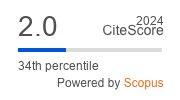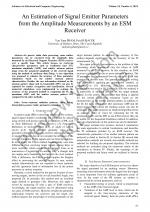| 4/2024 - 7 |
An Estimation of Signal Emitter Parameters from the Amplitude Measurements by an ESM ReceiverPHAM, V. T. |
| Extra paper information in |
| Click to see author's profile in |
| Download PDF |
Author keywords
antenna radiation patterns, curve fitting, interpolation, passive radar, parameter estimation
References keywords
localization(8), fitting(7), antennas(7), antenna(7), analysis(6), theory(4), tdoa(4), propagation(4), design(4), data(4)
No common words between the references section and the paper title.
About this article
Date of Publication: 2024-11-30
Volume 24, Issue 4, Year 2024, On page(s): 65 - 74
ISSN: 1582-7445, e-ISSN: 1844-7600
Digital Object Identifier: 10.4316/AECE.2024.04007
Web of Science Accession Number: 001415806000007
SCOPUS ID: 85211381585
Abstract
In passive radar data processing, some emitter parameters can be extracted from the amplitude data measured by an Electronic Support Measures (ESM) receiver over a specific time. This article focuses on retrieving characteristic parameters such as irradiation time (IT), maximum amplitude (AMP), and emitter antenna pattern shape from the measured amplitude of the received signal using the method of nonlinear data fitting. A new algorithm was proposed to enhance the accuracy of these parameter estimations based on the emitter antenna pattern characteristics. Besides, the new information obtained on the antenna pattern shape and its beamwidth (BW) can also be exploited for emitter recognition and classification. Several numerical simulations were implemented to evaluate the accuracy of the proposed method in computing the IT, the maximum AMP, and the emitter antenna pattern BW compared to the other methods. |
| References | | | Cited By «-- Click to see who has cited this paper |
| [1] R. Roberts, TDoA localization techniques. Harris Corporation, Melbourne, 2004, pp. 6-10
[2] R. Amiri, F. Behnia, A. Noroozi, "An efficient estimator for TDoA-based source localization with minimum number of sensors," IEEE Communications Letters, vol. 22, no. 12, pp. 2499-2502, 2018. [CrossRef] [SCOPUS Times Cited 65] [3] L. Zhang, T. Zhang, H.-S. Shin, "An efficient constrained weighted least squares method with bias reduction for TDoA-based localization," IEEE Sensors Journal, vol. 21, no. 8, pp. 10122-10131, 2021. [CrossRef] [SCOPUS Times Cited 52] [4] Y. S. Eroglu, I. Guvenc, N. Pala, M. Yuksel, "AOA-based localization and tracking in multi-element VLC systems," in 2015 IEEE 16th Annual Wireless and Microwave Technology Conference (WAMICON), Cocoa Beach, FL, 2015, pp. 1-5. [CrossRef] [SCOPUS Times Cited 35] [5] Q. Yan, J. Chen, "Robust AoA-based source localization in correlated measurement noise via nonconvex sparse optimization," IEEE Communications Letters, vol. 25, no. 5, pp. 1529 - 1533, 2021. [CrossRef] [SCOPUS Times Cited 15] [6] A. Amar, A. Weiss, "Localization of narrowband radio emitters based on Doppler frequency shifts," IEEE Transactions on Signal Processing, vol. 56, no. 11, pp. 5500-5508, 2008. [CrossRef] [SCOPUS Times Cited 261] [7] A. Yeredor, E. Angel, "Joint TDOA and FDOA estimation: A conditional bound and its use for optimally weighted localization," IEEE Transactions on Signal Processing, vol. 59, no. 4, pp. 1612 - 1623, 2011. [CrossRef] [SCOPUS Times Cited 113] [8] W. de Carvalho Rodrigues and J. Antonio Apolinario, "An emitter localization method based on multiple differential doppler measurements," in IEEE Latin America Transactions, vol. 20, no. 4, pp. 537-544, April 2022. [CrossRef] [SCOPUS Times Cited 13] [9] P. Hubacek, J. Vesely, Olivova, "Radar position estimation by sequential irradiation of ESM receivers," Sensors, vol. 21, no. 13, pp. 4430, 2021. [CrossRef] [SCOPUS Times Cited 3] [10] E. Moise, Elementary geometry from an advanced standpoint. Pearson College Div, 1990, pp. 231-242 [11] R. G. Wiley, ELINT: The interception and analysis of radar signals. Artech House, 2006, pp. 385-388 [12] S. Apfeld, A. Charlish, "Recognition of unknown radar emitters with machine learning," in IEEE Transactions on Aerospace and Electronic Systems, vol. 57, no. 6, pp. 4433-4447, Dec. 2021. [CrossRef] [SCOPUS Times Cited 26] [13] C. A. Balanis, Antenna theory: Analysis and design, Wiley, 2016, pp. 4-7 [14] A. Raghunathan, N. U. Shankar, R. Subrahmanyan, "An octave bandwidth frequency independent dipole antenna," in IEEE Transactions on Antennas and Propagation, vol. 61, no. 7, pp. 3411-3419, July 2013. [CrossRef] [SCOPUS Times Cited 15] [15] S. Rezaeeahvanouee, D. Dehmeshki, Y. Tousi, "Theoretical study and systematic design of multiport wire antenna," in IEEE Antennas and Wireless Propagation Letters, vol. 22, no. 9, pp. 2270-2274, Sept. 2023. [CrossRef] [SCOPUS Times Cited 5] [16] M. CetintaÅ, S. Cakır, O. Åen, M. Cınar, F. Ãstüner, "Loop antenna pattern measurements," in 29th Conference on Precision Electromagnetic Measurements (CPEM 2014), Rio de Janeiro, Brazil, 2014, pp. 192-193. [CrossRef] [SCOPUS Times Cited 1] [17] A. Vesa, F. Alexa, "A comparison between radiation pattern characteristics for array antennas," in 2011 6th IEEE International Symposium on Applied Computational Intelligence and Informatics (SACI), Timisoara, Romania, 2011, pp. 111-115. [CrossRef] [SCOPUS Times Cited 3] [18] J. L. Whitrow, "The radiation patterns of circular apertures," National Security and ISR Division, Edinburgh, SA, DST-Group-TR-3487, 2018 [19] J. D. Kraus, R. J. Marhefka. Antennas for all applications. McGraw-Hill, 2002, pp. 569-570 [20] Y. Rahmat-Samii and V. Galindo-Israel, "Shaped reflector antenna analysis using the Jacobi-Bessel series," in IEEE Transactions on Antennas and Propagation, vol. 28, no. 4, pp. 425-435, July 1980. [CrossRef] [SCOPUS Times Cited 104] [21] J. Wang and Y. Rahmat-Samii, "New cosine-q pattern formulas for the analysis of elongated-aperture antennas," in IEEE Transactions on Antennas and Propagation, vol. 72, no. 2, pp. 1893-1898, Feb. 2024, [CrossRef] [SCOPUS Times Cited 4] [22] P. J. Davis. Interpolation and approximation, Dover Publications, 2014, pp. 24-25 [23] M. Li, and L. D. Li, "A novel method of curve fitting based on optimized extreme learning machine," Applied Artificial Intelligence, vol. 34, no. 12, pp. 849-865, 2020. [CrossRef] [SCOPUS Times Cited 17] [24] T. Strutz, Data fitting and uncertainty, Springer Vieweg Wiesbaden, 2015, pp. 25-46 [25] H. Motulsky, Fitting models to biological data using linear and nonlinear regression: A practical guide to curve fitting. Oxford University Press, 2004, pp. 33-35 [26] G. Glatting, P. Kletting, S. N. Reske, K. Hohl, C. Ring, "Choosing the optimal fit function: Comparison of the Akaike information criterion and the Fâtest," Medical physics, vol. 34, no. 11, pp. 4285-4292, 2007. [CrossRef] [SCOPUS Times Cited 210] [27] S. I. Vrieze, "Model selection and psychological theory: A discussion of the differences between the Akaike information criterion (AIC) and the Bayesian information criterion (BIC)," Psychological Methods, vol. 17, no. 2, pp. 228-243, 2012. [CrossRef] [SCOPUS Times Cited 1379] [28] H. Motulsky, Fitting models to biological data using linear and nonlinear regression: A practical guide to curve fitting. Oxford University Press, 2004, pp. 143-148 [29] T. Strutz, Data Fitting and Uncertainty. Springer Vieweg Wiesbaden, 2015, pp. 32-33 [30] C. A. Balanis, Antenna Theory: Analysis and Design. Wiley, 2016, pp. 294-296 [31] C. A. Balanis Antenna Theory: Analysis and Design. Wiley, 2016, pp.173-174 Web of Science® Citations for all references: 0 SCOPUS® Citations for all references: 2,321 TCR Web of Science® Average Citations per reference: 0 SCOPUS® Average Citations per reference: 73 ACR TCR = Total Citations for References / ACR = Average Citations per Reference We introduced in 2010 - for the first time in scientific publishing, the term "References Weight", as a quantitative indication of the quality ... Read more Citations for references updated on 2025-07-02 09:40 in 120 seconds. Note1: Web of Science® is a registered trademark of Clarivate Analytics. Note2: SCOPUS® is a registered trademark of Elsevier B.V. Disclaimer: All queries to the respective databases were made by using the DOI record of every reference (where available). Due to technical problems beyond our control, the information is not always accurate. Please use the CrossRef link to visit the respective publisher site. |
Faculty of Electrical Engineering and Computer Science
Stefan cel Mare University of Suceava, Romania
All rights reserved: Advances in Electrical and Computer Engineering is a registered trademark of the Stefan cel Mare University of Suceava. No part of this publication may be reproduced, stored in a retrieval system, photocopied, recorded or archived, without the written permission from the Editor. When authors submit their papers for publication, they agree that the copyright for their article be transferred to the Faculty of Electrical Engineering and Computer Science, Stefan cel Mare University of Suceava, Romania, if and only if the articles are accepted for publication. The copyright covers the exclusive rights to reproduce and distribute the article, including reprints and translations.
Permission for other use: The copyright owner's consent does not extend to copying for general distribution, for promotion, for creating new works, or for resale. Specific written permission must be obtained from the Editor for such copying. Direct linking to files hosted on this website is strictly prohibited.
Disclaimer: Whilst every effort is made by the publishers and editorial board to see that no inaccurate or misleading data, opinions or statements appear in this journal, they wish to make it clear that all information and opinions formulated in the articles, as well as linguistic accuracy, are the sole responsibility of the author.



